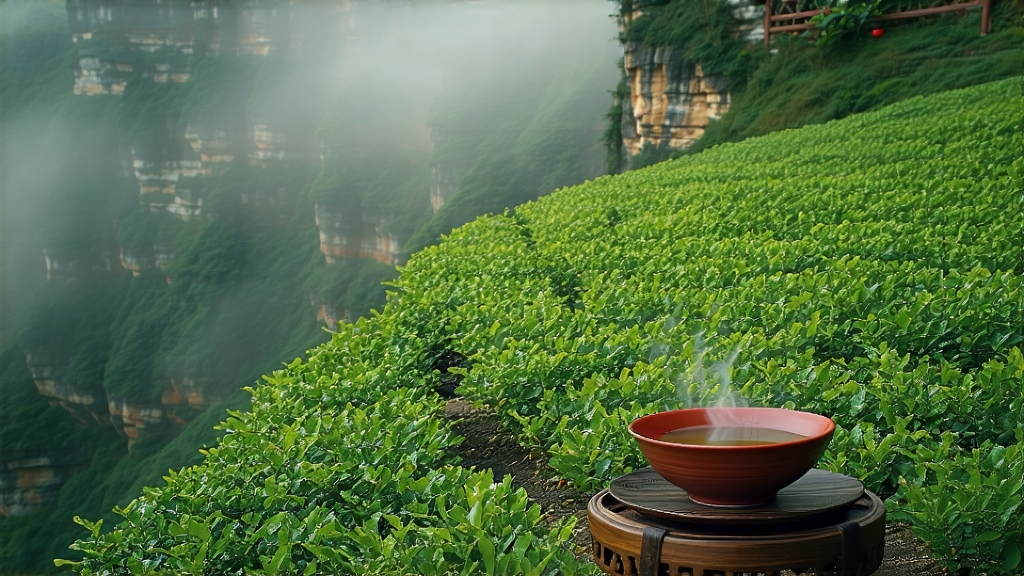
If green tea is China’s liquid springtime and pu-erh its earthy archive, then Da Hong Pao—Big Red Robe—stands somewhere between myth and geology, a tea that tastes of mineral, orchid and campfire smoke and carries a love story written on granite. Nestled in the UNESCO-listed Wuyi Mountains of northern Fujian, this oolong commands prices higher than gold when auctioned from the six “mother trees” that still cling to a narrow fissure on Jiulongke cliff. Yet the name now stretches far beyond those venerable bushes, embracing a family of related cultivars, production villages and roasting styles that together form the rock oolong universe known as Yancha. To understand Da Hong Pao is to decode how Chinese artisans translate terroir into flavor, time into aroma, and legend into everyday ritual.
Historical whispers place the birth of Da Hong Pao in the late Ming dynasty, when a scholarly monk or—depending on the teller—a passing imperial candidate was cured of illness by tea plucked from the cliff. He wrapped the bushes in his own scarlet robe to protect them from frost, hence the name. By the Qing, the tea had become tribute, carried on horseback through the Meiling pass to the Forbidden City. When the six mother trees were finally fenced off in 2006 to prevent over-picking, the region pivoted to vegetative propagation, grafting branches from the originals onto the hardy, mineral-loving Quekou or Beidou rootstocks. Today “pure” Da Hong Pao means leaf descended from those cuttings, while “blended” Da Hong Pao marries several Wuyi cultivars—typically Rou Gui for spice, Shui Xian for body and Qi Dan for orchid sweetness—to recreate the mother tree’s elusive profile.
The Wuyi range itself is the first co-author of flavor. Volcanic rock exfoliates into gravelly soil that drains instantly yet holds warmth; morning mists rise from the Jiuqu (Nine-Bend) River, refracting sunlight into soft, shifting stripes; and the cliffs radiate stored heat at night, creating a 10 °C diurnal swing that condenses sugars and aromatic oils in the leaf. Locals call this mineral signature yan yun—rock rhyme—a tactile hum that arrives minutes after swallowing, like the after-ring of a bronze bell. No other oolong, not even the high-mountain Taiwanese cousins, can replicate yan yun because no other place combines igneous terroir with subtropical humidity in precisely this ratio.
Crafting Da Hong Pao is a duet between farmer and fire. Picking occurs only in late April, when three half-mature leaves still cup a dew-bright bud. The pluck must be delivered to the factory within two hours; oxidation waits for no one. Inside, leaves are shaken in flat bamboo drums called lang qing—literally “cooling green”—where they bruise against themselves, rupturing cell walls to invite oxygen. This ban qing (half-green) stage is the heartbeat of oolong: too little shaking and the tea remains grassy; too much and it collapses into black-tea sweetness. Masters listen for a rustle like rain on paper, then pause to let latent heat dissipate, repeating the cycle up to eight times across the night. By dawn the edges of every leaf have turned chestnut while the centers stay jade, achieving the trademark “green leaf with red border.”
Next comes the kill-green, brief but fierce: 280 °C woks, two minutes, hands moving faster than the eye. The goal is not full desiccation but enzyme deactivation, locking in the 30–40 % oxidation that defines oolong. After a quick rolling to twist leaves into the traditional “dragonfly head” shape, the tea is ready for the step that terrifies novices—charcoal roasting. Wuyi is one of the last places where tea is still finished over a living fruit-wood fire. Masters bury glowing embers in ash to moderate heat, then spread leaf on bamboo sieves stacked inside a hooded roaster. Over the next 8–12 weeks the tea will be baked, rested, rebaked, up to three cycles, each drop of 5 °C revealing deeper layers: first honey, then orchid, then the coveted mineral bass note. During the “quiet month” the leaf sleeps in unglazed clay jars, breathing through microscopic pores, integrating smoke and rock